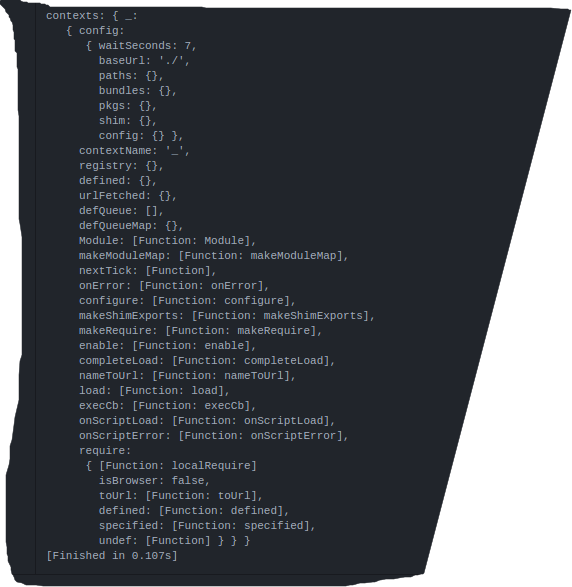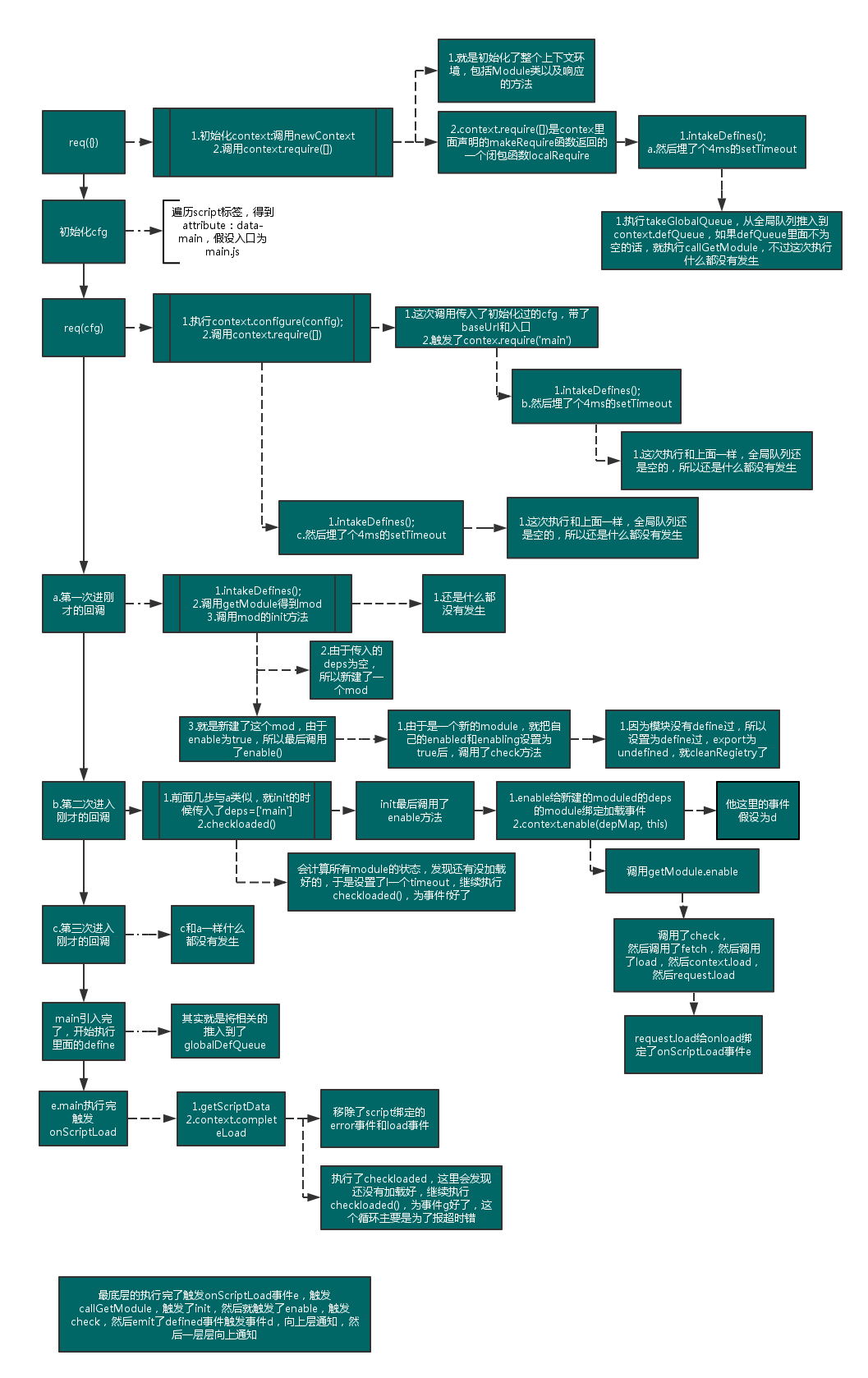一步一步带你分析 requirejs
详细源代码一共就2000多行,来看我这篇分析的同学应该都下载下来了,好了,话不多说,开始:
代码的开头就出现3个全局变量: requirejs, require, define
var requirejs, require, define;
(function(global, setTimeout){
balababla......
})(this, (typeof setTimeout === 'undefined' ? undefined : setTimeout)))
require 和 define 大家应该都知道上干什么的,说实话,我是不知道的,在分析代码的时候,我从来也没用过这个框架,就听过AMD,就来直接看源码了。
如果你也不是很清楚,这2个变量是干什么的,我就来简单介绍一下,懂得的同学要是发现我说错了,希望指点我也一下。
主页面 index.html:
注意src是引入我们的requirejs库, data-main:就是我们第一次用requrie的地方:
<html>
<head>
<title></title>
</head>
<body>
<script src="require.js" type="text/javascript" data-main="main.js"></script>
</body>
</html>
main.js:
这里2个代码块都是依赖require的:
(1)require.config:配置
(2)requrie(); 加载需要的函数,注意里面的 ['name', 'say'],其实都是文件名,它们都在./js/ 目录下,具体看conifg
require.config({
baseUrl: '',
paths: {
'nameDep': 'js/nameDep',
'say': 'js/say',
'name': 'js/name'
},
shim: {
'name': {
deps: ['nameDep']
}
}
});
require(['name', 'say'], function (name, say) {
say(name);
});
./js/name.js 和 ./js/say.js
//name
define([''], function () {
return '测试';
});
//say
define([], function () {
return function (name) {
console.log(name);
};
});
最后注意在config中有个skim,这里面也是定义js文件的,只是由于他可能不符合AMD加载的规范
./js/nameDep.js
console.log("nameDep.js")
以上分析,我们大概看得出 require 和 define 都是 function
--------------------------------------分割线-------------------------------------------------------------------------
下面进入2000多行匿名函数的讲解:
首先说一下2个参数: global 和 setTimeout
(function (global, setTimeout) {
})(this, (typeof setTimeout === 'undefined' ? undefined : setTimeout))
如果在浏览器的环境中,就是平时我们所知的 windows对象 和 windows.setTimeout方法 。本文只讨论浏览器环境,别的环境咱不考虑。
接下来就是一大堆的变量和函数的定义,太多了!反正我就扫了一眼,记不住?无所谓,只需要记住这开头这3个变量就行了:req,contexts,cfg
2个是空对象 cfg,contexts ,还有一个函数 req 。
为什么它是函数??? 你一拉到底,一定会看到 req = requirejs = function(){} 的定义,眼神不好也没关系,看我下面的代码框里有req({});
var req,
....
contexts = {},
cfg = {},
....
//各种function定义
....
//Create default context.
req({});
.....
好了把眼神定位到 req({})吧, 因为这是上面一大堆定义后,第一次执行了代码!!!!
req这个函数长什么样子?? 你用文字匹配往上找:
/**
* Main entry point.
*
* If the only argument to require is a string, then the module that
* is represented by that string is fetched for the appropriate context.
*
* If the first argument is an array, then it will be treated as an array
* of dependency string names to fetch. An optional function callback can
* be specified to execute when all of those dependencies are available.
*
* Make a local req variable to help Caja compliance (it assumes things
* on a require that are not standardized), and to give a short
* name for minification/local scope use.
*/
req = requirejs = function (deps, callback, errback, optional) {
//Find the right context, use default
var context, config,
contextName = defContextName; //开头定义了 defContextName = "_"
// Determine if have config object in the call.
if (!isArray(deps) && typeof deps !== 'string') {
// deps is a config object
config = deps;
if (isArray(callback)) {
// Adjust args if there are dependencies
deps = callback;
callback = errback;
errback = optional;
} else {
deps = [];
}
}
//第一次没有config.context 跳过
if (config && config.context) {
contextName = config.context;
}
//第一次context == undefined
context = getOwn(contexts, contextName);
//第一次进入
if (!context) {
//只有第一次会调用newContext("_")
context = contexts[contextName] = req.s.newContext(contextName);
}
if (config) {
context.configure(config);
}
return context.require(deps, callback, errback);
};
上面代码 context出现的频率非常高,说明这小子很重要。那我们来看看这小子到底是啥!!!
直接找到它的定义:
context = contexts[contextName] = req.s.newContext(contextName);
那 newContext 又是什么鬼! 搜它!!!!!
function newContext(contextName) {
var context
...
//一大堆function定义
....
context={
.....
}
context.require = context.makeRequire();
return context;
}
用20秒的时间扫一眼!老套路,一大堆的变量,函数的定义。 一直到最后return 一个 context变量。
再往上拉看看 context 到底是个什么鬼!!
记忆力没毛病的话,发现context对象里装的全是刚才定义过一些变量,函数。
-----------------------------------------------------------------------------------------------
| 其中return的上一行代码: |
| context.require = context.makeRequire(); |
| 有兴趣就去看一眼,很简单,就是返回一个叫localRequire的闭包 |
------------------------------------------------------------------------------------------------
OK,这个newContext函数我们已经差不多了解了,就是返回一个对象,通过这个对象控制newContext里的一系列私有变量和对象。
我们的contexts就如下图所示:

接下去走
context.configure(config);
我建议你去看一下,因为里面啥也没干,你只需要花10秒左右的时间就可以看完。。。
然后走
return context.require(deps, callback, errback);
看上面的图,context.require 就是 localRequire
接下来,我们走进localRequire的世界里一探究竟!!!!其中deps = [ ]
function localRequire(deps, callback, errback) {
var id, map, requireMod;
if (options.enableBuildCallback && callback && isFunction(callback)) {
callback.__requireJsBuild = true;
}
if (typeof deps === 'string') {
if (isFunction(callback)) {
//Invalid call
return onError(makeError('requireargs', 'Invalid require call'), errback);
}
//If require|exports|module are requested, get the
//value for them from the special handlers. Caveat:
//this only works while module is being defined.
if (relMap && hasProp(handlers, deps)) {
return handlers[deps](registry[relMap.id]);
}
//Synchronous access to one module. If require.get is
//available (as in the Node adapter), prefer that.
if (req.get) {
return req.get(context, deps, relMap, localRequire);
}
//Normalize module name, if it contains . or ..
map = makeModuleMap(deps, relMap, false, true);
id = map.id;
if (!hasProp(defined, id)) {
return onError(makeError('notloaded', 'Module name "' +
id +
'" has not been loaded yet for context: ' +
contextName +
(relMap ? '' : '. Use require([])')));
}
return defined[id];
}
//Grab defines waiting in the global queue.
intakeDefines();
//Mark all the dependencies as needing to be loaded.
context.nextTick(function () {
//Some defines could have been added since the
//require call, collect them.
intakeDefines();
requireMod = getModule(makeModuleMap(null, relMap));
//Store if map config should be applied to this require
//call for dependencies.
requireMod.skipMap = options.skipMap;
requireMod.init(deps, callback, errback, {
enabled: true
});
checkLoaded();
});
return localRequire;
}
很快我们就把目光锁定到(因为,前面的一大段代码都是if语句,不符合条件进不去)
//Grab defines waiting in the global queue.
intakeDefines();
intakeDefines --》takeGlobalQueue--》context.nextTick--》intakeDefines --》 requireMod.init --》 checkLoaded();
里面大致就是上面所示,因为有点复杂,我这里暂时先不说,接续走简单的。。
到此为止,我们已经走完了一边req。
大致流程如下图所示:

接下去,我们再一拉到底!!!!
倒数第二行:
//Set up with config info.
req(cfg);
cfg还记得是什么吗?? 一开始是定义为空对象啊!!!
有地方修改过它吗? 往上拉一拉!!
//Look for a data-main script attribute, which could also adjust the baseUrl.
if (isBrowser && !cfg.skipDataMain) {
//Figure out baseUrl. Get it from the script tag with require.js in it.
eachReverse(scripts(), function(script) {
//Set the 'head' where we can append children by
//using the script's parent.
if (!head) {
head = script.parentNode;
}
//Look for a data-main attribute to set main script for the page
//to load. If it is there, the path to data main becomes the
//baseUrl, if it is not already set.
dataMain = script.getAttribute('data-main');
if (dataMain) {
//Preserve dataMain in case it is a path (i.e. contains '?')
mainScript = dataMain;
//Set final baseUrl if there is not already an explicit one,
//but only do so if the data-main value is not a loader plugin
//module ID.
if (!cfg.baseUrl && mainScript.indexOf('!') === -1) {
//Pull off the directory of data-main for use as the
//baseUrl.
src = mainScript.split('/');
mainScript = src.pop();
subPath = src.length ? src.join('/') + '/' : './';
cfg.baseUrl = subPath;
}
//Strip off any trailing .js since mainScript is now
//like a module name.
mainScript = mainScript.replace(jsSuffixRegExp, '');
//If mainScript is still a path, fall back to dataMain
if (req.jsExtRegExp.test(mainScript)) {
mainScript = dataMain;
}
//Put the data-main script in the files to load.
cfg.deps = cfg.deps ? cfg.deps.concat(mainScript) : [mainScript];
return true;
}
});
}
这里面做的事情很简单,就是找到页面中包含 "data-main" 属性的script标签,分析路径。
最后得到这样的结果:

好了。再回到req(cfg);
这一次我们好好的走一走上面流程图里的步骤。。。。
把目光迅速锁定到:
return context.require(deps, callback, errback);






